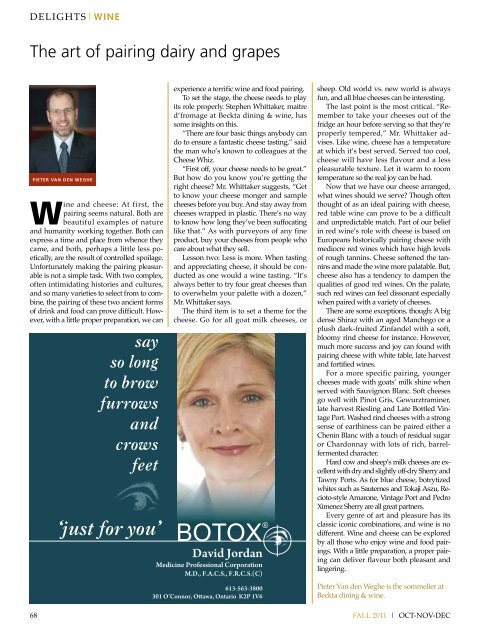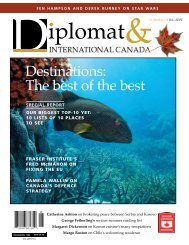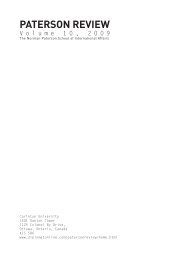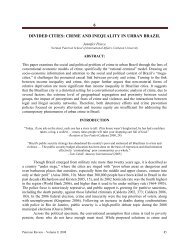the new petro power paradigm - Diplomat Magazine
the new petro power paradigm - Diplomat Magazine
the new petro power paradigm - Diplomat Magazine
Create successful ePaper yourself
Turn your PDF publications into a flip-book with our unique Google optimized e-Paper software.
DELIGHTS|WINE<br />
The art of pairing dairy and grapes<br />
Pieter Van den Weghe<br />
Wine and cheese: At first, <strong>the</strong><br />
pairing seems natural. Both are<br />
beautiful examples of nature<br />
and humanity working toge<strong>the</strong>r. Both can<br />
express a time and place from whence <strong>the</strong>y<br />
came, and both, perhaps a little less poetically,<br />
are <strong>the</strong> result of controlled spoilage.<br />
Unfortunately making <strong>the</strong> pairing pleasurable<br />
is not a simple task. With two complex,<br />
often intimidating histories and cultures,<br />
and so many varieties to select from to combine,<br />
<strong>the</strong> pairing of <strong>the</strong>se two ancient forms<br />
of drink and food can prove difficult. However,<br />
with a little proper preparation, we can<br />
68<br />
say<br />
so long<br />
to brow<br />
furrows<br />
and<br />
crows<br />
feet<br />
‘just for you’<br />
experience a terrific wine and food pairing.<br />
To set <strong>the</strong> stage, <strong>the</strong> cheese needs to play<br />
its role properly. Stephen Whittaker, maitre<br />
d’fromage at Beckta dining & wine, has<br />
some insights on this.<br />
“There are four basic things anybody can<br />
do to ensure a fantastic cheese tasting,” said<br />
<strong>the</strong> man who’s known to colleagues at <strong>the</strong><br />
Cheese Whiz.<br />
“First off, your cheese needs to be great.”<br />
But how do you know you’re getting <strong>the</strong><br />
right cheese? Mr. Whittaker suggests, “Get<br />
to know your cheese monger and sample<br />
cheeses before you buy. And stay away from<br />
cheeses wrapped in plastic. There’s no way<br />
to know how long <strong>the</strong>y’ve been suffocating<br />
like that.” As with purveyors of any fine<br />
product, buy your cheeses from people who<br />
care about what <strong>the</strong>y sell.<br />
Lesson two: Less is more. When tasting<br />
and appreciating cheese, it should be conducted<br />
as one would a wine tasting. “It’s<br />
always better to try four great cheeses than<br />
to overwhelm your palette with a dozen,”<br />
Mr. Whittaker says.<br />
The third item is to set a <strong>the</strong>me for <strong>the</strong><br />
cheese. Go for all goat milk cheeses, or<br />
BOTOX<br />
David Jordan<br />
Medicine Professional Corporation<br />
M.D., F.A.C.S., F.R.C.S.(C)<br />
613-563-3800<br />
301 O’Connor, Ottawa, Ontario K2P 1V6<br />
®<br />
sheep. Old world vs. <strong>new</strong> world is always<br />
fun, and all blue cheeses can be interesting.<br />
The last point is <strong>the</strong> most critical. “Remember<br />
to take your cheeses out of <strong>the</strong><br />
fridge an hour before serving so that <strong>the</strong>y’re<br />
properly tempered,” Mr. Whittaker advises.<br />
Like wine, cheese has a temperature<br />
at which it’s best served. Served too cool,<br />
cheese will have less flavour and a less<br />
pleasurable texture. Let it warm to room<br />
temperature so <strong>the</strong> real joy can be had.<br />
Now that we have our cheese arranged,<br />
what wines should we serve? Though often<br />
thought of as an ideal pairing with cheese,<br />
red table wine can prove to be a difficult<br />
and unpredictable match. Part of our belief<br />
in red wine’s role with cheese is based on<br />
Europeans historically pairing cheese with<br />
mediocre red wines which have high levels<br />
of rough tannins. Cheese softened <strong>the</strong> tannins<br />
and made <strong>the</strong> wine more palatable. But,<br />
cheese also has a tendency to dampen <strong>the</strong><br />
qualities of good red wines. On <strong>the</strong> palate,<br />
such red wines can feel dissonant especially<br />
when paired with a variety of cheeses.<br />
There are some exceptions, though: A big<br />
dense Shiraz with an aged Manchego or a<br />
plush dark-fruited Zinfandel with a soft,<br />
bloomy rind cheese for instance. However,<br />
much more success and joy can found with<br />
pairing cheese with white table, late harvest<br />
and fortified wines.<br />
For a more specific pairing, younger<br />
cheeses made with goats’ milk shine when<br />
served with Sauvignon Blanc. Soft cheeses<br />
go well with Pinot Gris, Gewurztraminer,<br />
late harvest Riesling and Late Bottled Vintage<br />
Port. Washed rind cheeses with a strong<br />
sense of earthiness can be paired ei<strong>the</strong>r a<br />
Chenin Blanc with a touch of residual sugar<br />
or Chardonnay with lots of rich, barrelfermented<br />
character.<br />
Hard cow and sheep’s milk cheeses are excellent<br />
with dry and slightly off-dry Sherry and<br />
Tawny Ports. As for blue cheese, botrytized<br />
whites such as Sauternes and Tokaji Aszu, Recioto-style<br />
Amarone, Vintage Port and Pedro<br />
Ximenez Sherry are all great partners.<br />
Every genre of art and pleasure has its<br />
classic iconic combinations, and wine is no<br />
different. Wine and cheese can be explored<br />
by all those who enjoy wine and food pairings.<br />
With a little preparation, a proper pairing<br />
can deliver flavour both pleasant and<br />
lingering.<br />
Pieter Van den Weghe is <strong>the</strong> sommelier at<br />
Beckta dining & wine.<br />
FALL 2011 | OCT-NOV-DEC

















